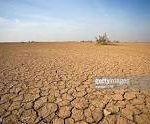INTRODUCTION
A drought is the situation of prolonged shortages in the water supply, that may be atmospheric (rainfall is less than 75% of the normal or below average precipitation), surface water or groundwater. It can have a substantial impact on the ecosystem and agriculture of the affected region. So it can harm the local economy of affected areas. Though, drought is a recurring feature of the climate in most parts of the world.
Agricultural Drought– It is the situation when water or moisture content in the soil is not sufficient to meet the demands of potential evapotranspiration. It is the most serious physical hazard to agriculture in nearly every part of the world.

CAUSES OF DROUGHT
- Shortage of precipitation- Precipitation is the major component of water cycle that deposits most fresh water on the earth. Precipitation includes rainfall, rizzle, sleet, snow, ice pellets, snow pillet, and hail.
- Dry season- The dry season greatly increases drought occurrence and is characterized by its low humidity, with watering holes and rivers drying up. Periods of warmth quicken the pace of fruit and vegetable production, increase evaporation and transpiration from plants and worsen drought conditions.
- Erosion & Human activities- Human activity can directly trigger worse factors such as over farming, excessive irrigation, deforestation, and erosion adversely impact the ability of the land to capture and hold water.
- Climatic changes- Activities resulting in global climate change are expected to trigger droughts with a substantial impact on agriculture throughout the world, and especially in developing nations.
EFFECTS OF DROUGHT
the consequences of drought can be grouped under three aspects as described below:
- Environmental effect- lower surface and water-levels, lower flow-levels, increased pollution of surface water, the drying out of wetlands, more and larger fires, higher deflation intensity, loss of biodiversity, worse health of tree plants and the appearance of pests and diseases. It also affects the water quality.
- Economical effect– It include low agricultural production due to low crop growth, lower forests, higher food-production costs, lower energy-production levels in hydro plants, losses caused by depleted water tourism and transport revenue, problems with water supply for the energy sector and for technological processes in metallurgy, mining, the chemical, paper, wood, foodstuff industries etc., disruption of water supplies for municipal economies.
- Social effects– It include the negative effect on the health of people directly exposed to excessive heat wave, limitation of water supplies, increased pollution levels, high food-costs etc. This explains why droughts and fresh water shortages operate as a factor which increases the gap between developed and developing countries.
Farmers can effectively mitigate much of the impact of drought through irrigation and crop rotation. Dams, watershed management, water harvesting and other water conservation practices can largely help in agriculture.
Read more..
DIFFERENCE BETWEEN CLIMATE & WEATHER
WHAT IS ATMOSPHERE- STRUCTURE & LAYERS
WHAT IS SOIL EROSION- TYPES & MECHANISM
FORMATION OF SOIL-PROCESS & FACTOR OF SOIL FORMATION
DIFFERENCE BETWEEN MANURE AND FERTILIZERS
INTEGRATED FARMING SYSTEM
AGRICULTURE IN INDIA: Development & Present Scenario